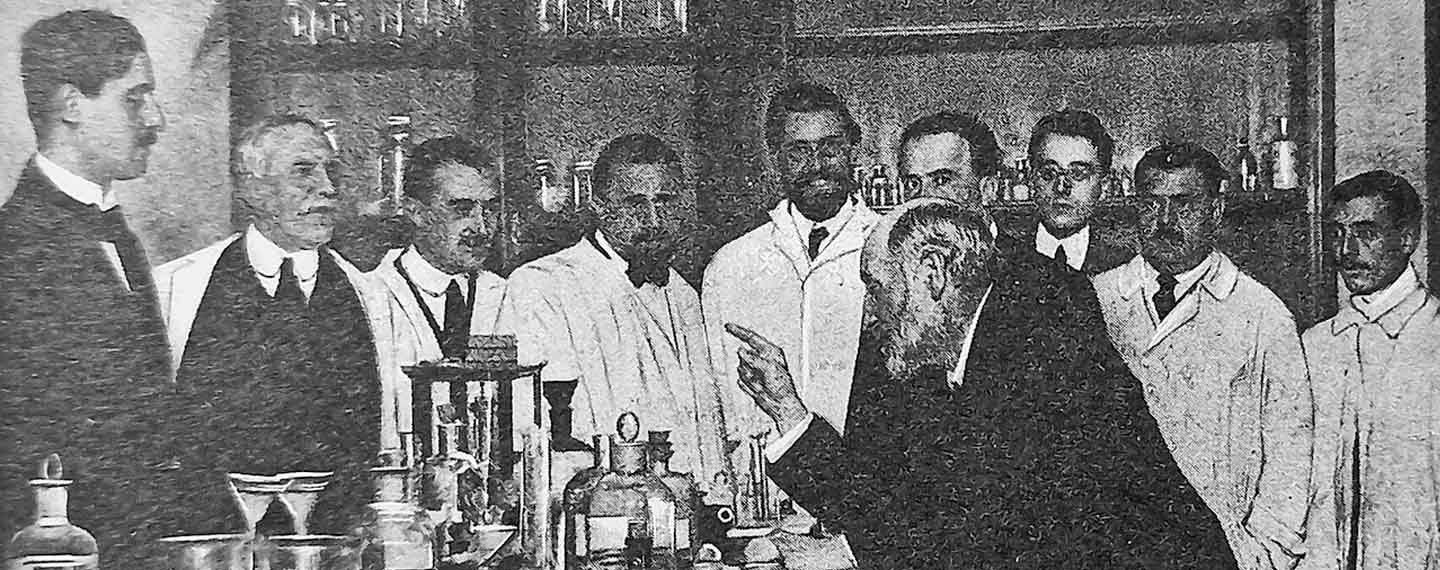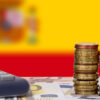Close to 90 years after his death, Santiago Ramón y Cajal (1852-1934) is probably still the most influential figure in the history of biology you have never heard of. He shared the Nobel Prize for Physiology or Medicine in 1906 with the Italian Camilo Golgi for their work on the structure of the nervous system.
At the ceremony, Golgi shocked the audience by attacking Cajal’s theory. This rivalry is at the heart of the first major biography –published in English last month– of Cajal, The Brain in Search of Itself: Santiago Ramón y Cajal and the Story of the Neuron (Farrar, Straus and Giroux), by Benjamin Ehrlich.
Cajal perfected Golgi’s staining technique, using silver nitrate, which allowed nervous tissue to be visualised in more detail than ever before. He then went on to show that each nerve cell is an independent entity and nerve synapses transfer nerve impulses from one cell to another. This ran up against Golgi’s theory, which held that the system comprised a continuous sheet of fibres, or reticulum. Cajal was right.
Cajal’s discovery made him one of the great biologists of the 19th century along with Darwin and Pasteur. His The Texture of the Nervous System of Man and the Vertebrates, known as the Textura,is to neuroscience what Darwin’s On the Origin of Species is to evolutionary biology. Sixty-six Nobel Prizes since Cajal’s death have been awarded for work in neuroscience.
The discovery was the result of a heroic and persistent struggle against all odds, leading him, when famous and a national hero, to denounce Spain’s historical disregard for science: ‘to do research in Spain is to cry’. Cajal criticised the science system for its hermeticism, under-funding, over-regulation and bureaucratic burdens, ailments which persist and undermine the ability of the country to attract international talent (brain gain) and retain its own (brain drain). Broadly speaking, this is still the case today.
In 2011, according to the OECD, the Paris-based think tank, there were 12,000 Spanish researchers working abroad. By 2015 there were an estimated 20,000, 10% of the total number working in Spain. Most if not all of them had been trained with public money, at an average cost of €500,000 (a €10 billion total investment). The number working in British universities that year was 40% higher than in 2012.[1] This exodus accentuated the ageing of Spain’s research community.
Spain’s R&D spending is among the lowest in the EU at 1.4% of GDP in 2020, a year when economic output declined a massive 11%, largely because of the impact of COVID (see Figure 1). Expenditure is well below the EU average of 2.3% and far from the 3% goal set by the European Council Lisbon Strategy for 2010.
Figure 1. R&D expenditure, 2009, 2015 and 2020 (% of GDP)
| 2009 | 2015 | 2020 | |
| Finland | 3.7 | 2.9 | 2.9 |
| Sweden | 3.4 | 3.2 | 3.5 |
| Germany | 2.7 | 2.9 | 3.1 |
| France | 2.2 | 2.2 | 2.3 |
| EU | 1.9 | 2.1 | 2.3 |
| Netherlands | 1.7 | 2.1 | 2.3 |
| Hungary | 1.1 | 1.3 | 1.6 |
| Italy | 1.2 | 1.3 | 1.5 |
| Spain | 1.3 | 1.2 | 1.4 |
| Poland | 0.6 | 1.0 | 1.4 |
Source: Eurostat.
Initially, a bad student, to the despair of his father, in an age when learning was literally beaten into you –as epitomised by the phrase, la letra con sangre entra, ‘knowledge comes with blood’– Cajal did not take to the rote system of learning (which still exists) as opposed to the method of critical thinking. At one point he dropped out of school. Under threat that he would be expelled, he returned and scraped through the exams. He was apprenticed first to a barber (his father was a barber-surgeon) and then to a cobbler.
Despite displaying an extraordinary gift for draughtsmanship, his father ordered him to study medicine. Cajal’s anatomical drawings are works of art and still populate textbooks and can also be seen on tattooed skin. He preferred drawing to photography. At 16 he accompanied his father on night-time raids of the public ossuary in the local cemetery, where they filled their sacks with crania, ribs, pelvises and femurs for examination at home.
His research took off when he acquired a cutting-edge microscope that magnified objects up to 800 times, the maximum possible at the time, bought with the money he earned as a medical officer in the army. Bent over the microscope, he locked himself away for countless hours of solitary observation (some years earlier the Swiss anatomist Albert von Kölliker visited the Museum of Natural Sciences in Madrid where he noticed a French microscope in a glass display case, and was told it had never been used and was just an object of curiosity).
He failed the oposición –the gruelling four-day competitive exam for public appointments that showcased verbal memory– twice until, on the third go, he passed the one for a position at the university of Valencia. The anatomical drawing he prepared for that part of the exam was so exquisite that one of the judges took the blackboard home.
In 1901 the government-funded Institute of Biological Investigations was opened, equipped with the latest technology. Cajal turned down the offer to be Education Minister in the Liberal government of Segismundo Moret (1905-06), preferring instead to focus on his work, but agreed to put forward a plan to reform the education system, including improving training and research, granting universities more autonomy and hiring better teachers.
The Nobel Prize catapulted him to national fame, so much so that it was said a letter could be sent to Cajal by addressing it with only his name. Many years later the same happened to Camilo José Cela, who won the Nobel Prize for literature in 1989, as I could testify at Cela’s home where I saw such envelopes addressed to him.
Cajal used his fame to berate politicians for refusing to acknowledge the role science plays in a successful society and for not fostering the activity of scientists. Had he not died in 1934 and survived Spain’s 1936-39 Civil War, it is unlikely the Franco regime would have tolerated him. Of the 41 researchers who can be counted as Cajal’s heirs, says Ehrlich, virtually all were exiled or fled. The War deprived Spain of its enlightened intellectual class. The Franco regime equated scientists with enemies of the state. The only other Spanish scientist to win the Nobel Prize (in 1959), Severo Ochoa, inspired by Cajal, left Spain in 1936, and by the time he won it he was also a US citizen.
The Franco regime purged the Cajal Institute and replaced the Committee for the Enhancement of Scientific Investigations and Studies, created in 1907 and headed by Cajal, with the National Research Council (CSIC), a state agency, whose mission was ‘to restore the classical and Christian unity of the sciences that was destroyed in the 18th century’. Cajal and followers were regarded as agnostics and their views automatically dismissed as false because they did not have God’s support. Golgi’s obsolete theory was revived in Spain. The regime took to heart the words of the philosopher Miguel de Unamuno (1864-1936), ‘Let others do the inventing’.
The democracy ushered in after the death of Franco in 1975 has not accorded science the position it has in the other large EU countries, to the chagrin of émigré researchers like Amaya Moro-Martín, Assistant Astronomer (tenure track) at the Space Telescopic Institute in Baltimore since 2014 and a constant critic of the policies of successive Spanish governments.[2]
Spain’s 2008-13 Great Recession, following the global financial crisis that hit the economic model excessively based on bricks and mortar and tourism hard, led governments to slash spending on research, a short-sighted policy, and impose a hiring freeze on scientists.
The Science Ministry, created for the first time in 2008, was absorbed into the Economy Ministry at the end of 2011, submitting research to an even more stifling bureaucracy. The Ministry was revived in 2018 and headed by the astronaut Pedro Duque. In 2013 a letter signed by 80,000 people protesting the government’s science policies was taped to the locked gates of the Economy Ministry, following the largest demonstration of researchers in Spanish history. Their demands were ignored: scientists, unlike, for example, pensioners (9 million in Spain) do not have political power.
Good intentions, however, have not been in short supply, as exemplified by the preamble to the 2011 Science, Technology and Innovation Law which reads: ‘Spain’s productive model […] is exhausted, making it necessary to drive change by committing to research and innovation as the means to attain a knowledge-based economy that guarantees more balanced, diversified and sustainable growth’. At the height of the real-estate boom, the construction sector accounted for 12% of GDP, when in any other developed country 5% is normal.
A national science funding agency was finally launched at the end of 2015, four years after the government’s pledge to do this, but it came with no new money, as it usurped existing research budgets.
When the Socialist-led minority government took office after the November 2019 election, it set a R&D spending target for the public and private sectors of 2% of GDP for 2023 (elections are due by the end of that year), a promise made in 2013 by the Popular Party (PP) government for 2020 and never fulfilled.
Reforming the 2011 law is currently going through parliament. The new law aims to boost public spending on R&D to 1.25% of GDP in 2030 and with private expenditure to an unrealistic 3%. The government wants to attract back émigré researchers, but this requires matching the conditions they have abroad, and hire many more in Spain. It plans to hire 12,000 researchers on indefinite contracts over the next three years, helped by Next Generation EU funds, and not on precarious short-term contracts that has generally been the case.
There is no multi-annual financing provision extending beyond the life of the government. Spain’s governments are particularly prone to overturning the reforms of their predecessor if it is of a different political colour. As with so many other issues, a national pact to foster science is required.
Transferring knowledge from the academic to the corporate world is also woefully inadequate. According to an OECD report[3] published last December, incentive mechanisms are ‘overly focused towards academic success criteria, resulting in outputs with low connection with the market, limited impact on protectable intellectual property and low rates of research commercialisation’.
The number of articles published in scientific publications has increased considerably in the last 30 years and also the number of projects approved by the European Research Council. Spain is ranked 11th in the world in scientific output, in line with the size of its economy (15 out of every 100 documents form part of the 10% of the most cited in the world), but 30th in innovation.
For almost 40 years, most of Cajal’s legacy, including 2,000 handwritten manuscripts, 14,000 histological slides and 2,000 scientific drawings have been stored at the Cajal Institute, part of CSIC. Until 1997 they were kept in shameful conditions. With 2022 officially declared the ‘Year of Ramón y Cajal Research’ and Cajal’s voluminous archives registered in UNESCO’s Memory of the World Register since 2017, it is a scandal there is still no museum on the great scientist, despite repeated promises. All that is lacking is the political will.
[1] See El éxodo de los investigadores españoles hacia el exterior: una marcha con consecuencias by Eva Ortega-Paíno & Eduardo Oliver, published in Revista de Occidente in December 2021.
[2] See the following articles: https://www.nature.com/articles/482277a and https://www.theguardian.com/science/political-science/2015/dec/19/an-open-letter-to-mariano-rajoy-from-an-emigre-researcher.
[3] Improving Knowledge Transfer and Collaboration between Science and Business in Spain, available at https://www.oecd-ilibrary.org/docserver/4d787b35-en.pdf?expires=1649232750&id=id&accname=guest&checksum=CFA07C446236074CD6220B7E8659F9DB.
Image: Santiago Ramón y Cajal teaching in his laboratory (Madrid 1910). Photo: El Libro de la Salud (1981) by A. Fernández-Cruz (Public domain / Wikimedia Commons)



